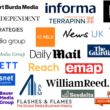Life is confusing for incumbents. Ask any business school student. It’s not meant to be easy for traditional market-leading, cash-generative companies quickly to reinvent themselves and carry on growing profits in the face of revolutionary change.
It will always seem easier for insurgents. They may be relatively poor but have few inhibitions and little to fear or to lose. They might also understand new things better. This has long seemed true in relation to the world’s traditional media companies, some of whom have seemed errr under-responsive to digitalisation. The digital immigrants are finding it hard to understand the young natives, let alone live with them.
In truth, media company financials (especially in TV) have suffered the confusion of systemic and cyclical change. But now the seismic plates really are shifting. Major developments on the web and in the high street are set to cause earthquakes in medialand – as well in retail. There are three major areas of development that might scare all but the very best consumer media companies over this next 12 months:
1. The explosion of online ‘TV’
In the week after 8million Americans watched Felix Baumgartner’s 128,000 ft sky-fall live, not on TV but on YouTube, it is even easier to believe that ‘Over The Top’ (OTT) or online TV will become a dominant entertainment force in many markets. The signs are everywhere. Germany, the UK and US saw huge online streaming audiences for the London Olympics. The UK’s youth channel SBTV is scoring 6million page views a month and is planning to go international (see recent Flashes & Flames post on SBTV). YouTube is pumping out increasing numbers of original channels and programmes. And there are multiplying film channels.
 OTT offers cookie-laden data for advertisers – and the scope for addressable ads and click-through purchasing. And it creates the opportunity for split screens to serve the increasingly large proportion of viewers who share TV with Facebook, Zeebox or Linkedin. Set-top boxes might help broadcasters get into the game (and BskyB in the UK is limbering up) but you wouldn’t bet on the ability of major TV networks to retain their audience leadership in this creative new world of proliferating channels and interactive services.
OTT offers cookie-laden data for advertisers – and the scope for addressable ads and click-through purchasing. And it creates the opportunity for split screens to serve the increasingly large proportion of viewers who share TV with Facebook, Zeebox or Linkedin. Set-top boxes might help broadcasters get into the game (and BskyB in the UK is limbering up) but you wouldn’t bet on the ability of major TV networks to retain their audience leadership in this creative new world of proliferating channels and interactive services.
One sideways glimpse of the new world was last week’s US election debate on HuffPost Live. Picture the scene: an animated discussion involving studio moderators playing clips of the debate; and, on the plasma screen, courtesy of Google Hangout (think Facebook-Skype-videoconferencing) are a handful of friends in different parts of the country discussing Obama and Romney. Gripping stuff, live and low-cost. HuffPost is owned by AOL, but it needn’t be. This type of ‘new’ TV is cheap, easy and coming fast.The key is commercial exploitation, of course. And that’s racing ahead too, although some channels will have to find ways to get out from under the powerful YouTube umbrella (audience intact) if they really want to coin it.
However, the Google-owned YouTube which has effectively pioneered OTT is still making the pace. It has just announced plans to launch no fewer than 60 new European programme channels over the next few months. YouTube  will be collaborating with major content producers (including the BBC, Endemol and Freemantle) to launch channels that will be a mix of personality-driven productions and specialist content for smaller audiences. Its first collaborations with the BBC will feature: chef-star Jamie Oliver; and a nature channel “On Earth”. At least 46 new channels will be directed at the three biggest European markets: the UK (21), Germany (12) and France (13). YouTube is clearly hoping to emulate its US success where its top 25 channels each average more than 1million weekly views.
will be collaborating with major content producers (including the BBC, Endemol and Freemantle) to launch channels that will be a mix of personality-driven productions and specialist content for smaller audiences. Its first collaborations with the BBC will feature: chef-star Jamie Oliver; and a nature channel “On Earth”. At least 46 new channels will be directed at the three biggest European markets: the UK (21), Germany (12) and France (13). YouTube is clearly hoping to emulate its US success where its top 25 channels each average more than 1million weekly views.
Although BskyB has launched NowTV , an online film channel in the UK, we should expect much more News Corp OTT activity, with or without its 40% subsidiary. One possibility must be a European launch for Hulu, the Fox partnership with NBC and Disney. This five-year-old streaming service was established to provide an online outlet for each of those studios, funded through advertising. It has since grown to offer content from other networks and web services for Facebook, MySpace and MSN. It also operates in Japan. Last year, Hulu notched up revenues of $420m – a 60% increase in two years.
Expect OTT plans also from Amazon. Aside from LoveFilm, its new Prime Instant Videos (original, streamed movies) will surely be woven into full-blown channels to compete with HBO and Sky Movies – perhaps with the viewer choosing whether to pay a subscription or put up with advertising. And who knows what the (eventual) launch of an Apple TV set may mean for online content and new channels? And what about Microsoft and its likely merger with Nokia?
It’s all getting European advertisers excited. The new YouTube channels will be heavily promoted, so ad agencies believe 2013 will be the start of explicit online competition for viewers. Stand by for an explosion in the number of OTT channels and the emergence of at least some early audience winners against network TV programmes. Internet ‘TV’ is about to become big news.
The OTT production boom and increasing sales of connected TVs and set-box boxes is expected to give viewers pre-set web channels that are as easy to access as TV broadcasts. Add to that the boom in non-TV set viewing (16% of all UK adults and 27% of 15-34 year olds regularly watch TV on PC, laptop or tablet; and similar in Australia) and you can almost touch the impending loss of broadcaster power in these countries.

As the internet channels extend to addressable ads, interactivity, and ecommerce so they will contribute to a blurring of media types. They will be offering it all: reading, listening, viewing, talking and buying. Families of these channels will become major brands – and YouTube will soon be better known for “real” programmes than for music or home video.
Further down the food chain, local broadcast TV (such as that being promoted by the UK government) may be upstaged by an explosion in local internet channels. In the UK, for one, there may be early attempts to provide national networks of regional online TV channels. Such services will include ecommerce and membership clubs. We will see the emergence of new-style local media groups on the lines of Gossweiler’s marvellous Swiss model (see below). Some newspaper groups could get there but they would have to get into video and turn their weakening local papers inside out. Partnerships or else?
2. A free publishing boom
The London Evening Standard last week proved the point. The longtime loss-making paid-for has become a profitable free newspaper. It joins independently-owned financial paper City AM and DMGT’s 13-year-old national tabloid Metro as successful free dailies in the UK capital. The rising success of the 2op i newspaper (from the publishers of the Evening Standard and The Independent) endorses this powerful tide of free and low-price, low-cost publishing.
 Other newspapers will be encouraged by major ad agencies which are already strong supporters of four free weeklies ( Short List, Stylist, Sport and recent-switch Time Out) and an upmarket fashion monthly aMUSE from Stephen Murphy, the whizzy co-founder of the seven-year-old monthly Square Mile. Free is now, well, totally respectable. The fact is that half of the UK’s 20 biggest circulation magazines (including the two largest) are free and/or sponsored by retailers.
Other newspapers will be encouraged by major ad agencies which are already strong supporters of four free weeklies ( Short List, Stylist, Sport and recent-switch Time Out) and an upmarket fashion monthly aMUSE from Stephen Murphy, the whizzy co-founder of the seven-year-old monthly Square Mile. Free is now, well, totally respectable. The fact is that half of the UK’s 20 biggest circulation magazines (including the two largest) are free and/or sponsored by retailers.
UK-based retailers (like Waitrose, John Lewis, Tesco, and ASOS) clearly see magazines as strong promotion especially for online shopping; and publishers seeking to develop ecommerce of their own need to get to the same place.
Advertisers either want relatively large and guaranteed levels of circulation and/or measurable impact and convertible sales leads: free hard copy and online together can be the answer. The just-announced switch of Newsweek to ‘digital only’ – and US research showing that the number of Americans who had read a hard copy newspaper the previous day has fallen from 41% to 23% in eight years – poses the question: Will hard copy newspapers and magazines be dominated by free titles published by new-wave operators rather than by traditional media groups?
London is pointing the way. The UK capital’s millions of railway commuters are now offered three free dailies and four free weekly  magazines. This is high-quality publishing and most are solidly profitable. It’s no wonder that paid-for newspaper and magazine sales have collapsed at railway newsstands.
magazines. This is high-quality publishing and most are solidly profitable. It’s no wonder that paid-for newspaper and magazine sales have collapsed at railway newsstands.
The free newspaper and magazine success seems to contradict the hard copy fears of traditional publishers. But there’s hard copy and hard copy: the new business model is working but, increasingly, the old one isn’t. It is now clear that, almost as quickly as traditional publishers abandon hard copy, new operators will move in to take their place. And, increasingly, the consequent media-bundling will include online TV as the separation of media types gets lost in the rush of internet channels. The newbies are advancing.
3. Internet invasion of the High Street
Maybe the success of bricks ‘n’ clicks retailers after a shaky start has made Amazon think it will, after all, need shops of its own. Or maybe it is the revelation that Apple’s 363 worldwide stores (once thought to be a mere promotional channel for online sales) are among the world’s most successful retail outlets. These shiny stores are generating $18bn revenues, 26% profit margins and $420k revenue  per employee – despite the apparent number of sightseers and people charging their iPhones.
per employee – despite the apparent number of sightseers and people charging their iPhones.
Maybe it is the open-secret plan for Microsoft to open up to 300 Apple-like stores and its trialling of ‘pop-up’ shops pre-Christmas. Or maybe it’s the recent disclosure that the world’s largest retailer Walmart is following US budget leader Target by no longer stocking Amazon’s Kindle. That decision seemed to coincide with Amazon founder’s Jeff Bezos’s admission that his hardware was being sold at a loss – in order to generate profitable online sales of books, newspapers and magazines. The early signs of Amazon’s likely swing into ‘bricks’ may be a host of pre-Christmas ‘pop up’ stores in the US, and perhaps also in London and Sydney.
Anyway, the safe money is on Amazon to create a store format which may offer innovative and speedy ways to download, rent and buy. Such stores will create an unwelcome new challenge for book stores but additional impetus for Amazon’s LoveFilm, not least in its fierece competition with Netflix. Interesting how long it has taken the visionary Bezos to arrive at the realisation that, long-term, the best retailers will be the most versatile (i.e. bricks and clicks). Amazon shops now seem obvious. Why not Google too? Expect some substantial partnerships, joint ventures or mergers between online, retail and traditional media. Retailing has never been more about media. And vice versa.
Summary
I believe the future is all about:
- Total Media: mobile web for TV, information, entertainment, mail/voice/Skype, social networking, ecommerce – and hard copy. How many of the established TV, newspaper, radio and magazine groups can get there? It’s not that media can’t survive and even thrive without retail, especially internationally. But the growth and scale will all be somewhere else.
- Total Retail: interchangeably on the high street, on the web, on TV, and in hard copy. How many major media operators will use their brands, content and relationships to become significant retailers? Or will Total Media be a carve-up (on the web and on the street) between powerful digital ‘immigrant’ retailers and media-savvy natives like ASOS, Amazon, Apple, and Net a Porter?
- Total Local: independent and networked micro-regional, web-based multimedia information, entertainment, and ecommerce. Some will be affiliates of major national/international providers (eg Amazon, Google, News Corp, John Lewis, Walmart or David Jones). Others will be progressive media groups. What price UK newspaper groups like Trinity Mirror or the Daily Mail cloning Urs Gossweiler’s vibrant Jungfrau Zeitung community media in the Alps? There will be even more visits this winter (see Flashes & Flames post on Gossweiler).
 The neat distinctions between new and old in media and retail are being washed away. The best ‘old’ retailers are fighting back impressively online but will now have to cope too with the digital natives on the street. Retail is potentially all over media. And, on a small-town level, a gap has opened in the territory once controlled so effectively by local newspapers and traders.
The neat distinctions between new and old in media and retail are being washed away. The best ‘old’ retailers are fighting back impressively online but will now have to cope too with the digital natives on the street. Retail is potentially all over media. And, on a small-town level, a gap has opened in the territory once controlled so effectively by local newspapers and traders.
Total Media will be driven by advertisers who see a multimedia internet of addressable ads, ecommerce, social networking, communications and data – overlapped hugely by Total Retail. Some worldwide digitals like Amazon, Apple, and Google will be trying to bring it all together. And local operators will have similar, scaled-down opportunities. UK trends suggest that new-style hard copy newspapers and magazines may be a bigger part of the whole media-retail mix than might once have seemed possible.
The world is spinning faster than you think.
Have you signed up to receive Flashes & Flames in your inbox?
http://flashesandflames.com Media Fortune, Fame & Folly



